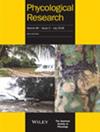' dinotom ' Durinskia baltica (Dinophyceae)的固醇是起源于鞭毛动物
IF 1
4区 生物学
Q2 MARINE & FRESHWATER BIOLOGY
引用次数: 3
摘要
“恐龙”是一组相对较小的甲藻,具有硅藻来源的异常第三质体,因此与大多数光合甲藻不同,后者具有类胡萝卜素色素周苷,并具有红藻来源的第二质体。作为我们实验室持续努力检查这种不寻常的甲藻以寻找其脂质成分进化的线索的一部分,我们检查了巴氏杜林斯基藻的甾醇成分。因此,我们在这里将其甾醇与之前研究的恐龙(Kryptoperidinium foliaceum)的甾醇进行了比较,更广泛地与其他光合的、含有周氨素的甲藻进行比较,并与硅藻属Nitzchia进行比较,后者被认为是D.baltica恐龙质体的祖先。甾醇是真核生物常见的环状脂质,被认为可以增强磷脂双层。许多含有周苷的甲藻具有甾醇成分,这些甾醇成分通过胆固醇(胆甾醇-5-en-3β-ol)和4种α-甲基取代的甾醇如二甾醇(4α,23,24-三甲基-5α-胆甾醇-22E‐en-3β-ol)的存在而富集;尽管其质体祖先异常,但这一点也被发现适用于三叶草。我们的目的是确定巴替卡龙是否也是如此,因为它是第二种对其甾醇进行详细表征的恐龙,并确定是否有任何迹象表明存在甲藻不常见的突出甾醇,可能来源于硅藻内共生体,正如先前在B.foliaceum和D.baltica叶绿体相关的透明硅藻来源的半乳糖脂质中所证明的那样。我们的研究结果表明,与叶栅藻一样,巴尔蒂卡藻的主要固醇是胆固醇、二甾醇和其他甲藻常见的4α-甲基取代固醇。尽管存在一些次要的甾醇,但没有发现明显来源于硅藻内共生体的甾醇,这表明大多数甾醇起源于甲藻宿主本身,很可能是在获得硅藻第三质体之前。本文章由计算机程序翻译,如有差异,请以英文原文为准。
Sterols of the ‘dinotom’ Durinskia baltica (Dinophyceae) are of dinoflagellate origin
‘Dinotoms’ are a relatively small group of dinoflagellates with aberrant tertiary plastids of diatom origin, thus differing from the majority of photosynthetic dinoflagellates which possess the carotenoid pigment peridinin and have secondary plastids of red algal origin. As part of our laboratory's continuing efforts to examine such unusual dinoflagellates in the search for clues to the evolution of their lipid compositions, we have examined the sterol composition of the dinotom Durinskia baltica. As such, we here compared its sterols to those of the previously examined dinotom, Kryptoperidinium foliaceum, more broadly to other photosynthetic, peridinin‐containing dinoflagellates, and to the diatom genus Nitzschia, which is the presumed ancestor of the D. baltica dinotom plastid. Sterols are ringed lipids, common to eukaryotes, thought to reinforce phospholipid bilayers. Many peridinin‐containing dinoflagellates have sterol compositions which are enriched by the presence of cholesterol (cholest‐5‐en‐3β‐ol) and 4α‐methyl‐substituted sterols such as dinosterol (4α,23,24‐trimethyl‐5α‐cholest‐22E‐en‐3β‐ol); this has also been found to be true for K. foliaceum despite its aberrant plastid ancestry. Our objective was to determine if this is also true for D. baltica as only the second dinotom to have its sterols characterized in detail, and to determine if there is any indication of prominent sterols which are uncommon to dinoflagellates, possibly originating from the diatom endosymbiont, as has been demonstrated previously with K. foliaceum and D. baltica chloroplast‐associated galactolipids of clear diatom origin. Our results demonstrate that like K. foliaceum, the major sterols of D. baltica are cholesterol, dinosterol, and other 4α‐methyl‐substituted sterols common to dinoflagellates. Although there were a number of minor sterols, none were found with obvious origin from the diatom endosymbiont, indicating that most originated with the dinoflagellate host itself, most likely before acquisition of the diatom tertiary plastid.
求助全文
通过发布文献求助,成功后即可免费获取论文全文。
去求助
来源期刊

Phycological Research
生物-海洋与淡水生物学
CiteScore
3.60
自引率
13.30%
发文量
33
审稿时长
>12 weeks
期刊介绍:
Phycological Research is published by the Japanese Society of Phycology and complements the Japanese Journal of Phycology. The Journal publishes international, basic or applied, peer-reviewed research dealing with all aspects of phycology including ecology, taxonomy and phylogeny, evolution, genetics, molecular biology, biochemistry, cell biology, morphology, physiology, new techniques to facilitate the international exchange of results. All articles are peer-reviewed by at least two researchers expert in the filed of the submitted paper. Phycological Research has been credited by the International Association for Plant Taxonomy for the purpose of registration of new non-vascular plant names (including fossils).
 求助内容:
求助内容: 应助结果提醒方式:
应助结果提醒方式:


